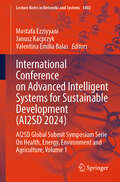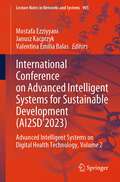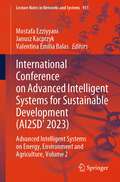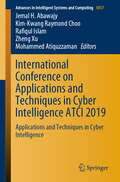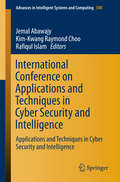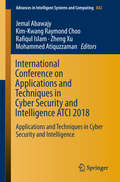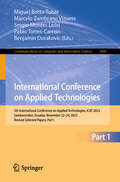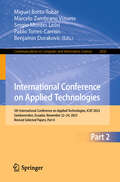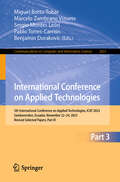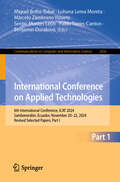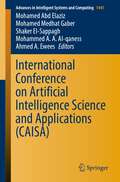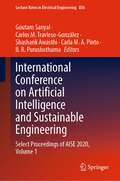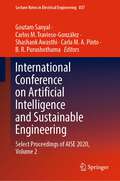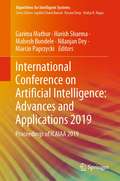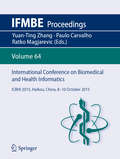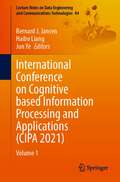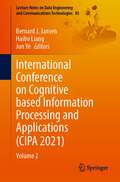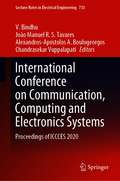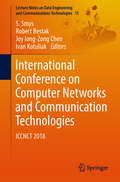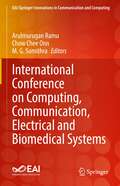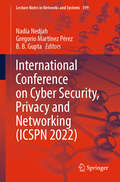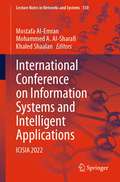- Table View
- List View
International Conference on Advanced Intelligent Systems for Sustainable Development: AI2SD Global Submit Symposium Serie On Health, Energy, Environment and Agriculture, Volume 1 (Lecture Notes in Networks and Systems #1402)
by Janusz Kacprzyk Valentina Emilia Balas Mostafa EzziyyaniThis book provides a dynamic platform for exploring groundbreaking advancements in intelligent systems for sustainable development. It offers readers&’ access to the latest technologies and innovative solutions that address global challenges. Bringing together leading academics, pioneering researchers, and industry leaders fosters knowledge exchange across various fields such as health, education, agriculture, energy, and security. It enables readers to gain valuable insights, build strategic partnerships, and contribute to shaping a more sustainable future. This book bridges scientific research with practical applications and is ideal for researchers, practitioners, and decision-makers, driving progress across multiple disciplines.
International Conference on Advanced Intelligent Systems for Sustainable Development: Advanced Intelligent Systems on Digital Health Technology, Volume 2 (Lecture Notes in Networks and Systems #905)
by Janusz Kacprzyk Valentina Emilia Balas Mostafa EzziyyaniThis book encapsulates the innovative discussions held during the International Conference on Advanced Intelligent Systems for Sustainable Development (AI2SD'2023), which took place at Mohammed 6 University of Sciences and Health Casablanca, Morocco. This book delves into the multifaceted realm of advanced intelligent systems, specifically focusing on digital health technology. The book offers a comprehensive exploration of cutting-edge research and breakthroughs in this dynamic field, providing a holistic perspective on the latest advancements. Within these pages, you will find papers covering an array of captivating topics, including AI-driven diagnostics, wearable health devices, predictive analytics in health care, and much more. Each contribution delves into the synergy of intelligent systems and digital health, showcasing how these technologies intertwine to shape the future of healthcare. Designed for researchers, practitioners, and enthusiasts alike, this book serves as an invaluable resource for staying updated on the latest trends and developments in the intersection of advanced intelligent systems and digital health technology. Whether you are seeking to broaden your knowledge or seeking practical insights, this book caters to a diverse readership eager to harness the potential of these innovative domains.
International Conference on Advanced Intelligent Systems for Sustainable Development: Advanced Intelligent Systems on Energy, Environment and Agriculture, Volume 2 (Lecture Notes in Networks and Systems #931)
by Janusz Kacprzyk Valentina Emilia Balas Mostafa EzziyyaniThis book is a comprehensive compilation of groundbreaking insights stemming from the esteemed International Conference on Advanced Intelligent Systems for Sustainable Development (AI2SD'2023), hosted at Cadi Ayyad University Morocco. Focused on the crucial themes of energy, environment, agriculture, and industry, this book captures the essence of transformative discussions and cutting-edge research that unfolded during the conference. Within these pages, readers are invited to explore the intricate world of intelligent systems, where innovation converges to tackle the key challenges of sustainability. The book immerses its audience in a wealth of knowledge that deeply represents the latest advancements shaping the future landscape. Diverse topics are intricately woven into the fabric of this discourse, covering AI-driven solutions designed for energy optimization, environmental sustainability, precision agriculture, and intelligent industry applications. Each contribution serves as a testament to the collaborative efforts of researchers, practitioners, and experts who gathered to drive innovation at the intersection of intelligent systems and sustainable development. Crafted as an invaluable resource, 'Advancements in Intelligent Systems: AI2SD'2023 Proceedings‘ caters to a diverse readership eager to delve into the forefront of trends and developments emerging from the crossroads of advanced intelligent systems in energy, environment, agriculture, and industry. Whether you're a researcher, practitioner, or enthusiast, unlock the transformative potential inherent in these innovative domains.
International Conference on Applications and Techniques in Cyber Intelligence ATCI 2019: Applications and Techniques in Cyber Intelligence (Advances in Intelligent Systems and Computing #1017)
by Jemal H. Abawajy Kim-Kwang Raymond Choo Rafiqul Islam Mohammed Atiquzzaman Zheng XuThis book presents innovative ideas, cutting-edge findings, and novel techniques, methods, and applications in a broad range of cybersecurity and cyberthreat intelligence areas. As our society becomes smarter, there is a corresponding need to be able to secure our cyberfuture. The approaches and findings described in this book are of interest to businesses and governments seeking to secure our data and underpin infrastructures, as well as to individual users.
International Conference on Applications and Techniques in Cyber Security and Intelligence
by Kim-Kwang Raymond Choo Jemal Abawajy Rafiqul IslamThis book presents the outcomes of the 2017 International Conference on Applications and Techniques in Cyber Security and Intelligence, which focused on all aspects of techniques and applications in cyber and electronic security and intelligence research. The conference provides a forum for presenting and discussing innovative ideas, cutting-edge research findings, and novel techniques, methods and applications on all aspects of cyber and electronic security and intelligence.
International Conference on Applications and Techniques in Cyber Security and Intelligence ATCI 2018: Applications And Techniques In Cyber Security And Intelligence (Advances In Intelligent Systems and Computing #842)
by Kim-Kwang Raymond Choo Jemal Abawajy Rafiqul Islam Mohammed Atiquzzaman Zheng XuThe book highlights innovative ideas, cutting-edge findings, and novel techniques, methods and applications touching on all aspects of technology and intelligence in smart city management and services. Above all, it explores developments and applications that are of practical use and value for Cyber Intelligence-related methods, which are frequently used in the context of city management and services.
International Conference on Applied Technologies: 5th International Conference on Applied Technologies, ICAT 2023, Samborondon, Ecuador, November 22–24, 2023, Revised Selected Papers, Part I (Communications in Computer and Information Science #2049)
by Miguel Botto-Tobar Marcelo Zambrano Vizuete Pablo Torres-Carrión Sergio Montes León Benjamin DurakovicThe three-volume proceedings set CCIS 2049, 2050 and 2051 constitutes the refereed proceedings of the 5th International Conference on Applied Technologies on International Conference on Applied Technologies, ICAT 2023, held in Samborondon, Ecuador, November 22–24, 2023. The 66 papers included in these proceedings were carefully reviewed and selected from 250 submissions. They are organized in sections by topics as follows: Intelligent Systems, Communications, e-Commerce, e-Government, e-Learning, Electronics, Machine Vision, Security, Technology Trends, and Z AT for Engineering Aplications.
International Conference on Applied Technologies: 5th International Conference on Applied Technologies, ICAT 2023, Samborondon, Ecuador, November 22–24, 2023, Revised Selected Papers, Part II (Communications in Computer and Information Science #2050)
by Miguel Botto-Tobar Marcelo Zambrano Vizuete Pablo Torres-Carrión Sergio Montes León Benjamin DurakovicThe three-volume proceedings set CCIS 2049, 2050 and 2051 constitutes the refereed proceedings of the 5th International Conference on Applied Technologies on International Conference on Applied Technologies, ICAT 2023, held in Samborondon, Ecuador, November 22–24, 2023. The 66 papers included in these proceedings were carefully reviewed and selected from 250 submissions. They are organized in sections by topics as follows: Intelligent Systems, Communications, e-Commerce, e-Government, e-Learning, Electronics, Machine Vision, Security, Technology Trends, and Z AT for Engineering Aplications.
International Conference on Applied Technologies: 5th International Conference on Applied Technologies, ICAT 2023, Samborondon, Ecuador, November 22–24, 2023, Revised Selected Papers, Part III (Communications in Computer and Information Science #2051)
by Miguel Botto-Tobar Marcelo Zambrano Vizuete Pablo Torres-Carrión Sergio Montes León Benjamin DurakovicThe three-volume proceedings set CCIS 2049, 2050 and 2051 constitutes the refereed proceedings of the 5th International Conference on Applied Technologies on International Conference on Applied Technologies, ICAT 2023, held in Samborondon, Ecuador, November 22–24, 2023. The 66 papers included in these proceedings were carefully reviewed and selected from 250 submissions. They are organized in sections by topics as follows: Intelligent Systems, Communications, e-Commerce, e-Government, e-Learning, Electronics, Machine Vision, Security, Technology Trends, and Z AT for Engineering Aplications.
International Conference on Applied Technologies: 6th International Conference, ICAT 2024, Samborondón, Ecuador, November 20–22, 2024, Revised Selected Papers, Part I (Communications in Computer and Information Science #2456)
by Miguel Botto-Tobar Marcelo Zambrano Vizuete Sergio Montes León Benjamin Durakovic Lohana Lema Moreta Pablo Torres-CarrionThis book constitutes the refereed proceedings of the 6th International Conference on International Conference on Applied Technologies, ICAT 2024, held in Samborondón, Ecuador, during November 20–22, 2024.The 25 full papers included in this book were carefully reviewed and selected from 95 submissions. They were organized in topical sections as follows: Computing; E-learning; Electronics; Technology Trends; Intelligent Systems; Machine Vision; and AT for Engineering Applications.
International Conference on Applied Technologies: 6th International Conference, ICAT 2024, Samborondón, Ecuador, November 20–22, 2024, Revised Selected Papers, Part II (Communications in Computer and Information Science #2457)
by Miguel Botto-Tobar Marcelo Zambrano Vizuete Sergio Montes León Benjamin Durakovic Lohana Lema Moreta Pablo Torres-CarrionThis book constitutes the refereed proceedings of the 6th International Conference on International Conference on Applied Technologies, ICAT 2024, held in Samborondón, Ecuador, during November 20–22, 2024.The 25 full papers included in this book were carefully reviewed and selected from 95 submissions. They were organized in topical sections as follows: Computing; E-learning; Electronics; Technology Trends; Intelligent Systems; Machine Vision; and AT for Engineering Applications.
International Conference on Artificial Intelligence Science and Applications (Advances in Intelligent Systems and Computing #1441)
by Mohamed Medhat Gaber Mohamed Abd Elaziz Mohammed A. A. Al-qaness Ahmed A. Ewees Shaker El-SappaghThis book collects different artificial intelligence methodologies that applied to solve real-world problems. This book has exciting chapters that employ artificial intelligence and applied to different applications based on integration with meta-heuristic and other techniques. The area of applications is including medical diagnosis, text analysis, cloud computing, and others which will enrich the reader. In this sense, the book provides practical and theory content with novel artificial intelligence techniques. The chapters were compiled using a scientific perspective. Accordingly, the book is primarily intended for undergraduate and postgraduate students of science, engineering, and computational mathematics and is applied in courses on artificial intelligence, optimization techniques, advanced machine learning, among others.
International Conference on Artificial Intelligence and Sustainable Engineering: Select Proceedings of AISE 2020, Volume 1 (Lecture Notes in Electrical Engineering #836)
by Carlos M. Travieso-González Goutam Sanyal Shashank Awasthi Carla M. A. Pinto B. R. PurushothamaThis book comprises select papers from the International Conference on Artificial Intelligence and Sustainable Engineering (AISE 2020). The volume focuses on the recent advancements in artificial intelligence and addresses how it is useful in achieving truly sustainable solutions. The key strands of this book include artificial intelligence in healthcare, IoT for modern life, security and surveillance, big data analytics, machine learning and computing, communication technologies, gesture technology, virtual intelligence, and audio & speech processing. The book addresses sustainability challenges in various computing techniques and opportunities for sustainable engineering based on AI and supporting tools such as engineering design for sustainable development using IoT/AI, smart cities: waste minimization, remanufacturing, reuse and recycling technologies using IoT/AI, industry 4.0, intelligent and smart grid systems, energy conservation using technology, green engineering/technology, robotic process automation (RPA) and water and air quality management. This book can be a valuable resource for academicians, researchers, and professionals working in AI and its applications.
International Conference on Artificial Intelligence and Sustainable Engineering: Select Proceedings of AISE 2020, Volume 2 (Lecture Notes in Electrical Engineering #837)
by Carlos M. Travieso-González Goutam Sanyal Shashank Awasthi Carla M. A. Pinto B. R. PurushothamaThis book comprises select papers from the International Conference on Artificial Intelligence and Sustainable Engineering (AISE 2020). The volume focuses on the recent advancements in artificial intelligence and addresses how it is useful in achieving truly sustainable solutions. The key strands of this book include artificial intelligence in healthcare, IoT for modern life, security and surveillance, big data analytics, machine learning and computing, communication technologies, gesture technology, virtual intelligence, and audio & speech processing. The book addresses sustainability challenges in various computing techniques and opportunities for sustainable engineering based on AI and supporting tools such as engineering design for sustainable development using IoT/AI, smart cities: waste minimization, remanufacturing, reuse and recycling technologies using IoT/AI, industry 4.0, intelligent and smart grid systems, energy conservation using technology, green engineering/technology, robotic process automation (RPA) and water and air quality management. This book can be a valuable resource for academicians, researchers, and professionals working in AI and its applications.
International Conference on Artificial Intelligence: Proceedings of ICAIAA 2019 (Algorithms for Intelligent Systems)
by Nilanjan Dey Marcin Paprzycki Mahesh Bundele Harish Sharma Garima MathurThis book introduces research presented at the “International Conference on Artificial Intelligence: Advances and Applications-2019 (ICAIAA 2019),” a two-day conference and workshop bringing together leading academicians, researchers as well as students to share their experiences and findings on all aspects of engineering applications of artificial intelligence. The book covers research in the areas of artificial intelligence, machine learning, and deep learning applications in health care, agriculture, business and security. It also includes research in core concepts of computer networks, intelligent system design and deployment, real-time systems, WSN, sensors and sensor nodes, SDN and NFV. As such it is a valuable resource for students, academics and practitioners in industry working on AI applications.
International Conference on Biomedical and Health Informatics: Icbhi2015, Haikou, China, 8-10 October 2015 (IFMBE Proceedings #64)
by Yuan-Ting Zhang Paulo Carvalho Ratko Magjarevic<P><P>This volume presents the proceedings of the International Conference on Biomedical and Health Informatics (ICBHI). The conference was a new special topic conference and a common initiative by the International Federation of Medical and Biological Engineering (IFMBE) and IEEE Engineering in Medicine and Biology Society (IEEE- EMBS). BHI2015 was held in Haikou, China, 8-10 October 2015. The main theme of the BHI2015 is “The Convergence: Integrating Information and Communication Technologies with Biomedicine for Global Health”. <P><P> The ICBHI2015 proceedings examine enabling technologies of sensors, devices and systems that optimize the acquisition, transmission, processing, storage, retrieval, use of biomedical and health information as well as to report novel clinical applications of health information systems and the deployment of m-Health, e-Health, u-Health, p-Health and Telemedicine.
International Conference on Cloud Computing and Computer Networks: CCCN 2023 (Signals and Communication Technology)
by Lei MengThis book covers selected and presented papers of CCCN 2023, the International Conference on Cloud Computing and Computer Network which was held in Singapore April 21-23, 2023. CCCN 2023 provides a premier forum for researchers and scholars from multiple disciplines to come together to share knowledge, discuss ideas, exchange information, and learn about cutting-edge research in diverse fields of cloud computing and computer networks. Topics covered in this book contain cloud computing and semantic web technologies, cloud applications in vertical industries, cloud computing architecture and systems, cloud computing models, simulations and designs among others. The content is relevant to academics, researchers, students, and professionals in cloud computing and computer networks.
International Conference on Cognitive based Information Processing and Applications: Volume 1 (Lecture Notes on Data Engineering and Communications Technologies #84)
by Jun Ye Bernard J. Jansen Haibo LiangThis book contains papers presented at the International Conference on Cognitive based Information Processing and Applications (CIPA) held during August 21, 2021, online conference (since COVID 19), which is divided into a 2-volume book. The papers in the first volume represent the various technological advancements in network information processing, graphics and image processing, medical care, machine learning, smart cities. It caters to postgraduate students, researchers, and practitioners specializing and working in the area of cognitive-inspired computing and information processing.
International Conference on Cognitive based Information Processing and Applications: Volume 2 (Lecture Notes on Data Engineering and Communications Technologies #85)
by Jun Ye Bernard J. Jansen Haibo LiangThis book contains papers presented at the International Conference on Cognitive based Information Processing and Applications (CIPA) held during August 21, 2021, online conference (since COVID 19), which is divided into a 2-volume book. The papers in the second volume represent the various technological advancements in network information processing, graphics and image processing, medical care, machine learning, smart cities. It caters to postgraduate students, researchers, and practitioners specializing and working in the area of cognitive-inspired computing and information processing.
International Conference on Communication, Computing and Electronics Systems: Proceedings of ICCCES 2019 (Lecture Notes in Electrical Engineering #637)
by João Manuel R. S. Tavares Joy Chen V. BindhuThis book includes high impact papers presented at the International Conference on Communication, Computing and Electronics Systems 2019, held at the PPG Institute of Technology, Coimbatore, India, on 15-16 November, 2019. Discussing recent trends in cloud computing, mobile computing, and advancements of electronics systems, the book covers topics such as automation, VLSI, embedded systems, integrated device technology, satellite communication, optical communication, RF communication, microwave engineering, artificial intelligence, deep learning, pattern recognition, Internet of Things, precision models, bioinformatics, and healthcare informatics.
International Conference on Communication, Computing and Electronics Systems: Proceedings of ICCCES 2020 (Lecture Notes in Electrical Engineering #733)
by João Manuel R. S. Tavares Chandrasekar Vuppalapati V. Bindhu Alexandros-Apostolos A. BoulogeorgosThis book includes high-quality papers presented at the International Conference on Communication, Computing and Electronics Systems 2020, held at the PPG Institute of Technology, Coimbatore, India, on 21–22 October 2020. The book covers topics such as automation, VLSI, embedded systems, integrated device technology, satellite communication, optical communication, RF communication, microwave engineering, artificial intelligence, deep learning, pattern recognition, Internet of Things, precision models, bioinformatics, and healthcare informatics.
International Conference on Computer Networks and Communication Technologies: Iccnct 2018 (Lecture Notes on Data Engineering and Communications Technologies #15)
by S. Smys Robert Bestak Joy Iong-Zong Chen Ivan KotuliakThe book features research papers presented at the International Conference on Computer Networks and Inventive Communication Technologies (ICCNCT 2018), offering significant contributions from researchers and practitioners in academia and industry. The topics covered include computer networks, network protocols and wireless networks, data communication technologies, and network security. Covering the main core and specialized issues in the areas of next-generation wireless network design, control, and management, as well as in the areas of protection, assurance, and trust in information security practices, these proceedings are a valuable resource, for researchers, instructors, students, scientists, engineers, managers, and industry practitioners.
International Conference on Computing, Communication, Electrical and Biomedical Systems (EAI/Springer Innovations in Communication and Computing)
by Chow Chee Onn Arulmurugan Ramu M. G. SumithraThis book presents selected papers from the International Conference on Computing, Communication, Electrical and Biomedical Systems (ICCCEBS 2021), held in March 2021 at KPR College of Engineering and Technology, Coimbatore, Tamil Nadu, India. The conference explores the interface between industry and real-time environments with newly developed techniques in computing and communications engineering. The papers describe results of conceptual, constructive, empirical, experimental, and theoretical work in areas of computing, communication, electrical, and biomedical systems. Contributors include academic scientists, researchers, industry representatives, postdoctoral fellows, and research scholars from around the world.
International Conference on Cyber Security, Privacy and Networking (Lecture Notes in Networks and Systems #599)
by Nadia Nedjah Gregorio Martínez Pérez B. B. GuptaThis book covers selected high-quality research papers presented in the International Conference on Cyber Security, Privacy and Networking (ICSPN 2022), organized during September 09–11, 2022, in Thailand in online mode. The objective of ICSPN 2022 is to provide a premier international platform for deliberations on strategies, recent trends, innovative approaches, discussions and presentations on the most recent cyber security, privacy and networking challenges and developments from the perspective of providing security awareness and its best practices for the real world. Moreover, the motivation to organize this conference is to promote research by sharing innovative ideas among all levels of the scientific community and to provide opportunities to develop creative solutions to various security, privacy and networking problems.
International Conference on Information Systems and Intelligent Applications: ICISIA 2022 (Lecture Notes in Networks and Systems #550)
by Khaled Shaalan Mostafa Al-Emran Mohammed A. Al-SharafiThis book sheds light on the fundamental and innovative topics in information systems and their societal impact on individuals and organizations. It mainly focuses on the role of artificial intelligence in organizations, human-computer interaction, IS in education and industry, and IS security, privacy, and trust. The outcomes are expected to assist the decision-makers in formulating the required policies and procedures for using cutting-edge technologies.
